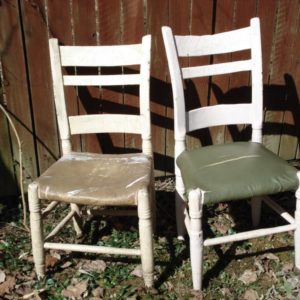I was recently given these two “Thumb-Back” chairs (see attached image, if I was successful in uploading it) by my mother, who bought them at a yard sale in Washington, D.C. at least 40 years ago. Although their seats are rather low (about 15″ to my dining room chairs’ 17″), they are suprisingly comftorable. I’d like to restore them to their original finish and seating materials. Currently, the layers of paint on them are so thick, I’m not even sure what wood they are. Before I tear off the old seating and strip the paint, I hope someone can tell me the history of this chair’s design and possibly maker(s). A “Google” search on this style came up with only reproductions for sale, but no historical information.
Thank you!
















Replies
I see similar forms in Sheraton Fancy chairs. These were often (nearly always) painted, sometimes with painted or stenciled designs. But, since as you noted, these are comfortable and fairly easy to make designs they have been widely reproduced and could date from just about any period.
Looks kind of like the left hand chair has been shortened? I don't know any historical significance of short size.
It's usually best to do structural repairs, if needed, before stripping paint. No worries about glue squeeze out, etc.
Is my monitor wonky? I'm "reading" the seating material almost like duct tape. Is there evidence under the covering of what was originally used, like rush.
Crows Nest,
What Steve said. They are "vernacular" expressions by country woodworkers of the "fancy chairs" popular in the early to mid 1800's in this country. The date on these may be later, as the style was popular way longer in thebackwaters of style.
If you are in the DC area, it may be worth your while to take an afternoon and visit the Museum of the Shenandoah, in Winchester, VA. They are currently running an exhibition on vernacular chairs of the Shenandoah Valley, which you may find interesting. The guest curator, Jeff Evans, has an auction house here in Rockingham County, and is quite knowledgeable on chairs of this type.
If you google Jeff Evans auctions, you may be able to get his email from his auction website, and shoot him a message with the photos. Possibly he may be able to tell you if he recognises these as being from the Valley. The turnings on the front legs of these type chairs are very individualistic, and can serve as an indicator of who the makers of your chairs may have been- each maker apparently used his own pattern for the turnings.
Of course, chairs like these were made all over, not just in the Valley. West of DC the little Quaker village of Waterford, VA had an active chairmaking industry, about which the local historical society has written a small book. Doubtless elsewhere in Loudon, PrinceWM and Fairfax countys, and nearby Md, there were other makers turning (heh) out similar designs.
Steve, chairs of this type I've seen typically have woven splint bottoms. Occasionally, rush was used, and nowadays, here in the Valley, you'll often see replacement bottoms woven in various basket weave or herringbone patterns of sisal "binder twine", which is surprisingly attractive.
Ray
This forum post is now archived. Commenting has been disabled